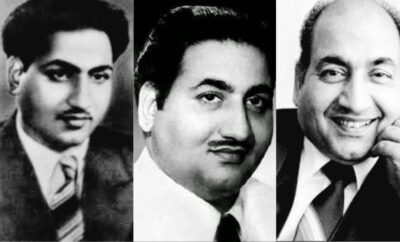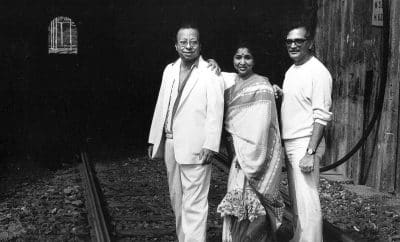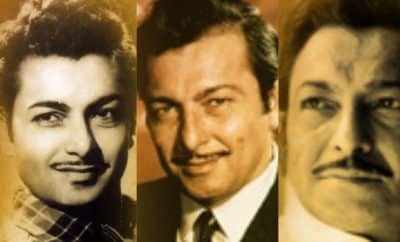Song Sketch
Khilte Hain Gul Yahan – Sharmilee – Of Roses And Romance
Two songs of opposing nature. Does that mean tandem songs or does that mean twin songs? Or both or neither? Because even if tandem means one after the other or alongside the other, in music it might not mean so. Specially in Hindi film music tandem comes as male-female version or sad-happy version mostly. And then there are twin songs which are picturised in succession. They come one after another in the film, joined at the same scene. They might be termed as a double header, meaning one song rendered in succession of the another. They are 2 songs picturized one after the other but are independent songs altogether in the same situation. While I write this, I think Mose chhal kiye jaaye – Kya se kya ho gaya from Guide give us the perfect example of both things above. We have already one article of such songs here. Two songs of opposing nature and yet are similar are almost like identical and nonidentical twins. Language also have similar twins – mix and match, null and void, wear and tear, rock and roll and so on. They are catchy because of the alliteration. They form a type of rhythm in words. In music too songs with opposing nature try to grab our attention because of the conflicting or contrast lyrics or the sad/happy tunes. Their being dissimilarly similar makes all the difference. Something like mirror image. And yet they stand as 2 independent songs. Just as twins. Incidentally Sharmilee (1971) is also a story about the twins – Kanchan/Kamini. Both sisters are in love with Shashi Kapoor and he’s confused about his choice since they are sisters.
Khilte hain gul yahan
Khil ke bikharne ko
Milte hain dil yahan
Mil ke bichhadne ko…..
One version rendered by Kishore Kumar and the other by Lata Mangeshkar. One is happy, the other is sad. Neeraj gives the opposites as one in the mukhda itself. Khilna-Bikharna, Milna-Bichhadna. The male version begins with a flute which gives you a striking resemblance with the beginning of – Mere sapnon ki rani kab aayegi tu…followed by Kishore Kumar humming romantically. On screen Shashi gives a 1000 watt gorgeous smile (why not he’s all set to impress Rakhee) while the ‘Neeraj naina’ Rakhee is more than happy for the attention she’s getting from him. In between the exchange of a rose and a stealing glance, violins, dholak, accordions exchange their notes too. The first antara is about inviting her and impressing her.
Kal rahe na rahe, mausam ye pyaar ka
Kal ruke na ruke, dola bahaar ka
Chaar pal mile jo aaj pyaar mein guzaar de….
While the weather is still in its glory let us spend these days cocooned in love. Just loving and living in the moment. Because these beautiful moments will pass away with the time and the glory of this weather will vanish very soon.
The second antara is building an atmosphere around. Lyrics here again are opposite – jheel/megh, thandi/aag. Santoor helps in making the atmosphere more romantic.
Jheelon ke honthon par, meghon ka raag hai
Phoolon ke seene mein, thandi thandi aag hai
Dil ke aaine mein tu ye samaa utaar le….
Capture the image of nature in your heart….it is reflecting love everywhere. The lakes, the clouds, the flowers are yearning to be loved, so am I.
The third antara is all about izhaar and ikraar indirectly. Expressing and accepting.
Pyasa hai dil sanam, pyasi ye raat hai
Honthon mein dabi dabi koi meethi baat hai
Inn lamhon pe aaj tu har khushi nisaar de….
The night in all its splendour desires love, the heart desires love, the subdued tenderness in the heart desires love too. Surrender yourself to these longings. Surrender to the happiness and the wantonness.
Now we head in the opposite direction. Lata Mangeshkar version. Unlike Kishore’s version which is all about love in its glory, Lata’s version begins with reminiscing about it. And S D Burman perfectly begins it with haunting aalap. Lata somewhat drags the lyrics and it is just her voice and tabla. Rakhee in a crisp white saree almost does the ghost act amongst the tall, thick coniferous trees. Shashi limps towards the direction of familiar voice and words. S D Burman mixes and matches moods too along with the instruments. Violins that sound arid, sitar is full of sympathy. S D Burman dramatizes the situation more with abrupt end to the stanza followed by ‘lunga pausa’. And we have the romance back with santoor and flute competing each other, the romance though sounds a bit uncertain. Both songs based on Raag Bhimpalasi, an afternoon raag. The female version sounds more classical in nature. It is said that for female version S D Burman was inspired by O nirdayi preetam from Stree (1961) (The resemblance is surely there). Both the versions follow one single music pattern over and over, throughout the song and it is this feature that makes it different from other songs. S D Burma once again proves that monotonous is not boring, on the contrary it comes with a double delight.




Pingback: Carnival of Blogs on Golden Era of Hindi Film Music, March 2019 – The world is too small? or Is it?
Shailesh Dahyalal Pujara
November 10, 2019 at 6:20 pm
Himalay Ki God mein – ek tu jo mila, saari duniya mili, khila jo mera dil sari bagiya khili and ek tu na mila, sari duniya mile to bhi kya hai, mera dil na khila, saari bagiya khile to bhi kya hai.
There are more songs of opposite nature. But cannot recollect now.